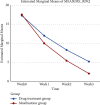Effects of Du Meridian Moxibustion Combined with Mild Moxibustion on Female Pelvic Floor Myofascial Pain Syndrome: A Retrospective Cohort Study
- PMID: 36425258
- PMCID: PMC9681563
- DOI: 10.1155/2022/7388864
Effects of Du Meridian Moxibustion Combined with Mild Moxibustion on Female Pelvic Floor Myofascial Pain Syndrome: A Retrospective Cohort Study
Abstract
Objective: This study aimed to investigate the efficacy and safety of moxibustion in the treatment of pelvic floor myofascial pain syndrome.
Methods: A total of 80 women with pelvic floor myofascial pain syndrome (cold coagulation and blood stasis type) were included in this retrospective study and divided into a moxibustion group and a drug treatment group. Patients who received Celebrex oral analgesia, health education, and lifestyle improvement were included in the drug treatment group. The patients that received Du meridian moxibustion combined with mild moxibustion, health education, and lifestyle improvement were included in the moxibustion group. The comparison of pelvic pain, the TCM clinical symptom score, and the curative effect was made between the two groups before treatment and after 1-3 weeks of treatment, respectively.
Results: An intragroup comparison showed a stepwise decrease in the VAS score and the TCM clinical symptom score of the two groups during the treatment. An intergroup comparison revealed that the VAS score of the moxibustion group was lower than that of the drug treatment group, while TCM clinical symptoms and clinical efficacy significantly improved in the moxibustion group compared to those in the drug treatment group (P < 0.05).
Conclusion: Du meridian moxibustion combined with mild moxibustion alleviates pelvic floor myofascial pain syndrome, thus helping improve women's quality of life and providing patients with a more effective and safer treatment plan.
Copyright © 2022 Yehong Wei et al.
Conflict of interest statement
The authors declare no conflicts of interest in this study.
Figures




Similar articles
-
[CO2 laser moxibustion for endometriosis related pelvic pain of cold coagulation and blood stasis: a randomized controlled trial].Zhongguo Zhen Jiu. 2022 Apr 12;42(4):397-401. doi: 10.13703/j.0255-2930.20210421-0001. Zhongguo Zhen Jiu. 2022. PMID: 35403398 Clinical Trial. Chinese.
-
Trigger point injections followed by immediate myofascial release in the treatment of pelvic floor tension myalgia.Arch Gynecol Obstet. 2023 Apr;307(4):1027-1035. doi: 10.1007/s00404-022-06880-y. Epub 2022 Dec 14. Arch Gynecol Obstet. 2023. PMID: 36513896
-
[A Randomized Controlled Clinical Trial for Treatment of Shoulder-back Myofascial Pain Syndrome with Mild Moxibustion at Trigger Points].Zhen Ci Yan Jiu. 2016 Aug 25;41(4):334-7. Zhen Ci Yan Jiu. 2016. PMID: 29071929 Clinical Trial. Chinese.
-
Pelvic floor myofascial pain severity and pelvic floor disorder symptom bother: is there a correlation?Am J Obstet Gynecol. 2019 Sep;221(3):235.e1-235.e15. doi: 10.1016/j.ajog.2019.07.020. Epub 2019 Jul 15. Am J Obstet Gynecol. 2019. PMID: 31319079 Free PMC article.
-
Physical examination techniques for the assessment of pelvic floor myofascial pain: a systematic review.Am J Obstet Gynecol. 2018 Nov;219(5):497.e1-497.e13. doi: 10.1016/j.ajog.2018.06.014. Epub 2018 Jun 28. Am J Obstet Gynecol. 2018. PMID: 29959930 Free PMC article.
Cited by
-
An update comprehensive review on the effects of transcutaneous electrical nerve stimulation for postnatal physical and psychological disorders.Front Neurol. 2025 Jun 25;16:1594422. doi: 10.3389/fneur.2025.1594422. eCollection 2025. Front Neurol. 2025. PMID: 40635704 Free PMC article. Review.
-
Research Trends of Acupuncture Therapy on Chronic Pelvic Pain Syndrome from 2000 to 2022: A Bibliometric Analysis.J Pain Res. 2023 Nov 30;16:4049-4069. doi: 10.2147/JPR.S434333. eCollection 2023. J Pain Res. 2023. PMID: 38054110 Free PMC article. Review.
References
LinkOut - more resources
Full Text Sources

